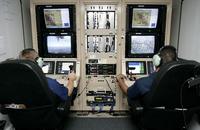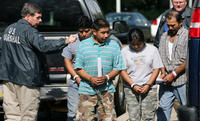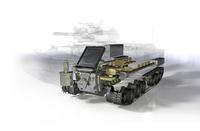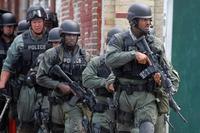-
Tamerlan Tsarnaev's name was on U.S. terror watchlist since 2011

In March 2011, after being contacted by the Russian security services, the CIA added the name of Tamerlan Tsarnaev to the U.S. government’s terror watchlist. DHS secretary Janet Napolitano said that Tamerlan’s travel to Dagestan, and his arrival back in the United States, were “pinged” by the department. Leading lawmakers have raised questions about whether the U.S. intelligence community and law enforcement agencies have dropped the ball on the Tsarnaev brothers.
-
-
Critics say drones make little contribution to border security

A new report says that U.S. Customs and Border Protection (CBP) drones are a wasteful giveaway to defense contractors and a threat to civil liberties. The report cites CBP own figures, the contribution drones make to border security is minimal. According to CBP calculations, drones have played a role in only 0.003 percent in drug seizure and 0.001 percent in illegal border crossing apprehensions.
-
-
Dzhokhar Tsarnaev had no firearms, explosives with him when captured
More details have emerged to shed light on the last few hours before 19-year old Dzhokhar Tsarnaev was captured hiding on a boat in Watertown, Massachusetts. Tsarnaev had no weapons or explosives with him in the boat where he was hiding. Boston police officers say that the heavy fire directed at the boat was probably the result of chaos of the moment. In a tense and charged atmosphere, one accidental shot could have caused what police call “contagious fire.” Tsarnaev sustained severe injuries, some of them to his neck and lower jaw, preventing him from talking. This led to rumors in the press that he tried to take his own life, but failed. We now know that he could not have tried to take his life because he had no firearms with him on the boat.
-
-
Deportations go on while immigration reform debate continues

The Obama administration has continued to deport illegal immigrants even as the fight over immigration reform goes on. President Obama has said his administration will not stop deportation orders until immigration reform has been passed, but immigration reform advocates say the administration should stop deporting immigrants who would be eligible for the path to citizenship under the terms of the Gang of Eight immigration overhaul bill.
-
-
Israel's military intelligence: Assad forces used chemical weapons

Israeli military intelligence for the first time publicly said that the Syrian military used chemical weapons in an attack on civilians on 19 March. Brig. Gen. Itai Brun, the head of AMAN’s (Israel’s military intelligence) research division, said that information gathered by Israel’s military intelligence, some of it pubic, some of it not, indicates that the weapon used in the attack outside Aleppo was sarin nerve gas. Brun said the Syrian regime has used sarin gas in several other small-scale attacks. Syria has the world’s largest arsenal of chemical weapons.
-
-
Improving emergency radio communication
Radio communications can be unreliable in underground tunnels and other large, complicated structures, posing a safety hazard for emergency responders. New tests of wireless emergency safety equipment by the National Institute of Standards and Technology (NIST) have defined the challenges more precisely and suggest how emergency communications might be improved.
-
-
Winner announced in the first DARPA FANG Challenge

The Ground Systems team outpaces more than 200 teams and 1,000 participants, submitting the winning mobility in the Fast Adaptable Next-Generation Ground Vehicle (FANG) Mobility/Drivetrain Challenge, and drivetrain subsystem design and claiming the $1 million prize.
-
-
Akron University professor teaches students on how to spot terrorist plots
Professor David Licate, a professor at the University of Akron, wants his students to be aware of those who may be buying bomb-making materials. In his class last Friday, Licate stressed to his homeland security course students that the community needs to look out for warning signs or suspicious behavior in an effort to prevent future tragedies.
-
-
Lawmakers want to learn more about the 2011 FBI investigation of Tamerlan Tsarnaev

Representative Michael McCaul (R-Texas), chairman of the House Homeland Security Committee, and Representative Peter King (R-New York), the former chairman of the committee, sent a letter to FBI director Robert Mueller and Attorney General Eric Holder, seeking answers about the Tamerlan Tsarnaev investigation by the FBI.In 2011, Russian security authorities requested that the FBI question Tsarnaev on suspicion that he was affiliated with Islamic Chechen insurgents, but after interviewing Tsarnaev and doing a background check, the FBI concluded there was not enough to justify continuing tracking of cTamerlan.
-
-
Hagel reassures Israel, discusses large arms deal
U.S. Defense Secretary Chuck Hagel arrived in Israel Sunday for his first visit in the country as secretary of defense. Some elements in the pro-Israel lobby in the United States campaigned against Hagel’s nomination, and Hagel went out of his way to assure Israelis that his position on Israel is not what it was portrayed to be. One of the main reasons for Hagel’s visit is to discuss a major U.S. arms deal that would offer Israel missiles for its fighter aircraft – but also plus KC-135 refueling planes which could be used in a long-range strike on a country such as Iran. Until now, the United States refused to sell refueling tankers to Israel.
-
-
Hawaii debating creation of a state homeland security office
Lawmakers in Hawaii are discussing the state’s Department of Defense the idea of creating a new homeland security office with. Supporters of the plan say having a DHS office will help improve efforts to prevent terrorist attacks in Hawaii. Critics are not so sure.
-
-
FBI releases images of bombing suspects
The FBI yesterday released videos and photographs of two young men, saying both are suspects in the Boston Marathon bombings. The agency warned that the two suspects should be regarded as armed and dangerous. The FBI was also analyzing cellphone tower records to identify positive hits for signs of calls which may have been placed to trigger both explosions remotely. Investigators are also interested in a battery believed to be used in one of the bombs. The battery was likely purchased with a remote control toy and then extracted so it could be used in the bomb. That could potentially make it easier to zero in on a suspect.
-
-
DHS cuts funds for programs aiming to prevent a McVeigh-like fertilizer bombing attacks

Timothy McVeigh used two tons of fertilizer and $3,000 of racing fuel to detonate a bomb outside the Alfred Murrah Federal Building in Oklahoma City in 1995. The blast killed 168 people. The Obama administration is currently not allocating money or resources to preventing fertilizer bombing attacks like the one McVeigh used, according to a former DHS official with direct knowledge of the department’s budgeting and operations.
-
-
DHS-funded police gear blurs line between crime-fighting and war-fighting

DHS is funding the purchase of military gear by Bay Area police departments. Critics of the program say the money allocated for the war on terror is blurring the line between local law enforcement focusing on crime fighting and soldiers fighting in an enemy war zone.
-
-
Federal security grants to Kansas City cut
DHS has removed Kansas City from the list of cities receiving DHS grants, which means that the city will now have to rely on its own resources to train local law enforcement on how to predict, spot, and react to terrorist activities.
-
More headlines
The long view
Why Ukraine’s AI Drones Aren’t a Breakthrough Yet
Machine vision, a form of AI, allows drones to identify and strike targets autonomously. The drones can’t be jammed, and they don’t need continuous monitoring by operators. Despite early hopes, the technology has not yet become a game-changing feature of Ukraine’s battlefield drones. But its time will come.
